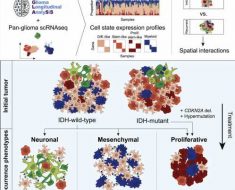Patients with nonmetastatic neuroendocrine tumors (NETs) can live for years and are more likely to die from a noncancer-related cause than from their cancer, new data from a population-based retrospective cohort study indicates.
“NETs are unique in two ways: First, they are slow growing, meaning that patients can live for years with a NET even if it has spread to more than one organ,” first author Julie Hallet, MD, University of Toronto, Toronto, Ontario, Canada, told Medscape Medical News.
“Second, they can produce hormones that can make people feel quite sick, but because people can live for a long time even with active disease, this means that the goals of treatment for NETs are very different than for other cancers — we often cannot cure the cancer, but we can control it by controlling the amount of tumor as well as the amount of hormones produced by the tumor,” she said.
“Our results show that some patients with nonmetastatic NETs are more likely to die of other causes than NET and this is crucial to inform patients and make decisions regarding treatment as it’s important to make sure that treatment does not present a higher risk than the NET itself,” Hallet commented in a statement.
For example, patients who have small NETs in the pancreas, stomach, or rectum could be monitored rather than have them undergo invasive surgery, since the risk of mortality from surgery could be higher than the risk of mortality from the NET itself, she elaborated.
The study was published in the August issue of The Journal of the National Comprehensive Cancer Network.
Commenting on the findings, Whitney Goldner, MD, vice-chair of the National Comprehensive Cancer Network guidelines panel for neuroendocrine tumors, felt that the findings “shed important light” on the complex issue of predicting long-term survival and the factors associated with it in NETs.
“NETs are a very heterogeneous group of malignancies,” Goldner said in a statement, “so they require individualized treatment recommendations for each primary tumor site [and] it is insightful to learn about the different patterns of both cancer- and noncancer-specific mortality specific to primary tumor site as well as other contributing factors,” she noted.
Goldner added that the new results will help to inform future guidelines regarding monitoring and treatment of different NETs and enable providers to more accurately manage site-specific NET counseling
Primary Outcome
The study reviewed data on 8607 patients diagnosed with NETs between January 2001 and December 2015. The most common primary tumor site was bronchopulmonary at 22.8% of the cohort, followed by small intestine at 19.3%, and rectum at 14.4%. Slightly over 42% of the cohort had metastases.
“Our primary outcome was death after NET diagnosis, classified as cancer-specific death or noncancer death,” Hallet and colleagues note.
At 5 years, 67.1% of the cohort overall were still alive, while at 10 years, 55.1% were still alive. Overall for all the patients together, the risk of cancer-specific death was higher than that of noncancer death, the authors report. For example, at 5 years, 27.3% of patients had died of a cancer-specific cause compared with only 5.6% of patients who had died from a noncancer-related cause. At 10 years, mortality rates were 34.5% vs 10.3%, respectively.
However, the rates of cancer-specific vs noncancer-specific deaths varied depending on whether patients had metastatic disease, the researchers observe.
Among patients with metastatic disease, “the risk of cancer-specific death largely exceeded that of noncancer death immediately after diagnosis,” Hallet and colleagues report. Indeed, only after 8 years from the diagnosis did the risk of noncancer-related causes of death slightly exceed that of cancer-specific death at 11.7% vs 10.2%, respectively, at 10 years, they add.
Different mortality patterns were also observed depending on where the primary NET had occurred before it metastasized.
|
Table 1. Five- and 10-Year Mortality by Primary NET Site |
||
|
Primary NET Site |
5-Year Mortality Rate |
10-Year Mortality Rate |
|
Bronchopulmonary NET |
36.4% |
42.7% |
|
Pancreatic NET |
34.8% |
48.4% |
|
Colonic NET |
21.4% |
26.6% |
For nonmetastatic NETs, the cumulative incidence of cancer-specific death was actually lower than death caused by noncancer causes. For example, for nonmetastatic gastric NETs, 10.4% of patients had died of a noncancer-related cause compared with only 5.8% of patients who died of a cancer-specific death. At 10 years, 18.9% of patients with a nonmetastatic gastric NET had died of a noncancer-related cause compared with 9% of those who died of a cancer-specific cause.
“The same was observed for nonmetastatic small intestine NETs,” Hallet and colleagues report. At 5 years, 13% had died of a noncancer-related cause compared with 4.7% of those who had died of a cancer-specific cause. At 10 years, 22.4% of those with a nonmetastatic small intestine NET had died of a noncancer-related cause compared with 8.6% of those who had died of a cancer-specific cause.
The same pattern was seen for patients with both nonmetastatic colonic and rectal NETs.
|
Table 2. Colonic vs Rectal NETs: Noncancer- and Cancer-Related Mortality |
||||
|
|
Noncancer-Related |
Cancer-Specific |
||
|
|
5-year mortality rate |
10-year mortality rate |
5-year mortality rate |
10-year mortality rate |
|
Colonic NET |
6.4% |
11.4% |
4.1% |
5.9% |
|
Rectal NET |
2.7% |
6.6% |
7.4% |
9.3% |
Hallet has disclosed speaking honoraria from Ipsen Biopharmaceuticals and Novartis Oncology, as well as travel support from the Baxter Corporation. Goldner has disclosed grant or research support from Roche Laboratories and Siemens Medical Solutions Diagnostics.
J Natl Compr Canc Netw. 2021;19(8):935-44. Full text
For more news, follow Medscape on Facebook, Twitter, Instagram, and YouTube.
Source: Read Full Article





